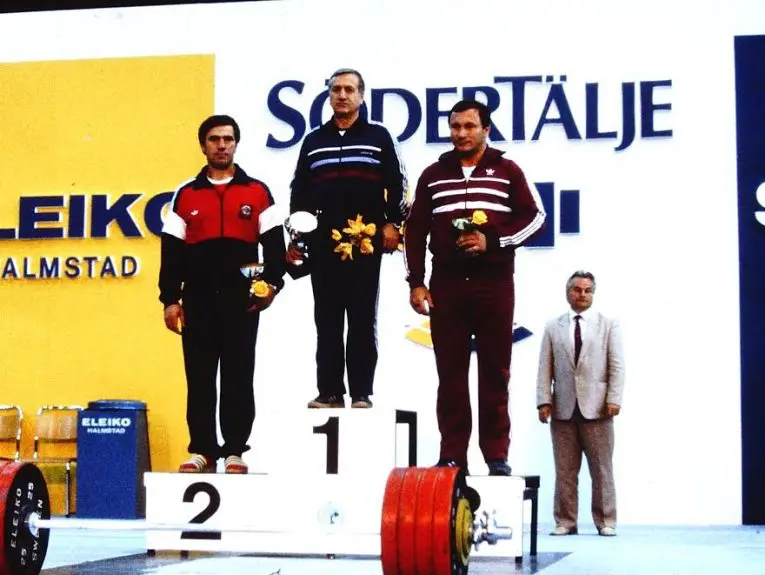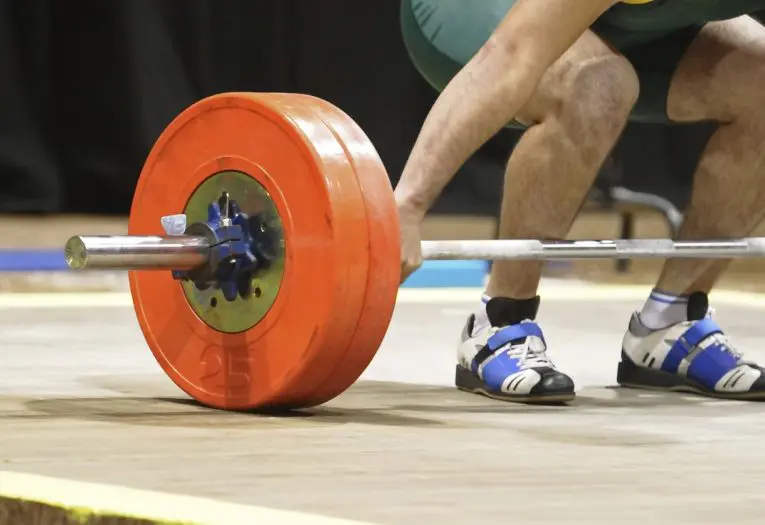There is an abundance of training programs out there designed specifically for the beginner and intermediate lifter.
However, for the more advanced lifter, finding a training program or structure that will is demanding enough, can be difficult.
This is partly due to the fact that highly conditioned lifters and athletes tend to need greater training frequency and intensity in order to bring about significant changes.
With its high frequency and great intensity, the Bulgarian Method makes the perfect choice for advanced lifters.
This article will outline the principles of the Bulgarian Method and provide the information required to effectively incorporate it into your training and build serious strength.
The Bulgarian Method Origins
In 1957, Bulgarian athlete Ivan Abadjiev won the country’s first-ever gold medal in weightlifting.
Level Up Your Fitness: Join our 💪 strong community in Fitness Volt Newsletter. Get daily inspiration, expert-backed workouts, nutrition tips, the latest in strength sports, and the support you need to reach your goals. Subscribe for free!
After retiring from the sport, Abadjiev served as the head coach of the Bulgarian Weightlifting Federation between the years of 1968 and 1989, and then again between 1997 and 2000.

In addition to coaching the Bulgarians, he also had a shorter stint with the Turkish Weightlifting Federation during the 1990s.
Despite having a relatively small population and limited resources, the Bulgarian Weightlifting Federation experienced great success with Abadjiev as head coach.
During his time as head coach, he produced twelve Olympic champions, fifty-seven World champions, and sixty-four European champions.
His success did not go unrecognized. Abadjiev was awarded the “Coach of the Year Of Bulgaria” on six occasions and, in 2001, he was also named as Bulgaria’s coach of the twentieth century.
Much of this success has been attributed to the training programs that Abadjiev prescribed to his athletes.
His training methods were seen as unconventional as he would typically have his athletes train for eight hours almost every single day.
It had been rumored that Abadjiev’s idea to train his athletes for long periods of time came from watching the Harlem Globetrotters.
He saw that they would train all day, every day, and still maintain an extremely high level of performance. If these basketballers could do this, why couldn’t his athletes?
A more realistic theory is that he based his training approach on the works of Felix Meerson, a USSR professor who specifically studied the body and how it adapts when exposed to stress.
Regardless of what truly inspired the Bulgarian Method, the training methods that he used with his athletes clearly paid dividends.
His training method is now commonly known as the “Bulgarian Method”. It can be used by a wide range of athletes who are looking to improve their strength and specific lifts.
Therefore, the Bulgarian Method is particularly effective for strength-sport athletes such as weightlifters and powerlifters.
Advanced Strength Training
With that said, this type of training is not for everyone. Remember, this program was used by elite level athletes and is highly demanding.
Consequently, this program should not be used by beginners and intermediates. It should only really be performed by those who are highly conditioned and have a lot of experience with strength training.
The main reason for this is that the program uses an extremely high frequency that is simply too high for beginners and intermediates.
As a result, they will not be able to cope with the demands of the workouts thus leading to overtraining and potential injury (1).
For those who are at an elite level, however, this training program can lead to substantial improvements in strength.
Some lifters have found that by following the program they were able to add as much as twenty-five to fifty pounds to their lifts.
Preparing For The Bulgarian Squat Method
Even for those who are highly trained, it may be necessary to run an undulating strength training program prior to starting a Bulgarian Method program.
Not only will this build a solid base for you to start from, but it will also give you time to get accustomed to undulating training.
Undulating periodized programs simply manipulate the training volume and / or weight loads on a day to day basis.
It is important that you familiarize yourself with this as the weights that you will be using in a Bulgarian Method program will likely undulate on a daily basis.
Once you have completed an undulating strength training program, you can then progress onto a Bulgarian Method program.
The Bulgarian Squat Method
It’s important to recognize the Bulgarian Method is more a set of training principles rather than a specific training plan.
Therefore, this section will cover a number of the training principles that Abadjiev applied with his athletes.
High Frequency
As mentioned, the Bulgarian Method utilizes high frequency. While you won’t be asked to perform grueling eight-hour workouts per day, you are to perform heavy squats basically every day.
The purpose of this frequency is not only to place a demand on the muscles and force them to adapt, but it is also to improve technique efficiency.
If athletes were struggling with specific lifts, Abadjiev would prescribe an extremely high frequency of this lift in order to improve the athlete’s technique.
As with any task, the more you perform it, the better you tend to become at it. Therefore, by improving squatting efficiency as well as muscular strength, you will find that you can lift more weight.
“Maxed Out” Sets
With every workout, you will start by establishing your daily max for the squat. Begin with a warm-up and gradually add weight to the bar until you can only perform one rep. This should only take a few sets to accomplish.
While this weight should be heavy and extremely challenging, you should not sacrifice form in order to lift a heavier load as this may lead to injury.
In addition, it is recommended that you avoid hyping yourself up for your maximal set as this may contribute to mental fatigue and interfere with your recovery from training sessions.
One of the benefits of using a daily max is that your strength levels can fluctuate on a day-to-day basis.
Level Up Your Fitness: Join our 💪 strong community in Fitness Volt Newsletter. Get daily inspiration, expert-backed workouts, nutrition tips, the latest in strength sports, and the support you need to reach your goals. Subscribe for free!
For example, poor hydration levels have been found to detrimentally impact strength performance (2).
Therefore, performing daily max sets allows you to consider these strength-influencing factors and ensure that you are training at the right intensity.
Another benefit of using a daily max is that fatigue will quickly become a factor and will also impact how you perform.
Because you are lifting heavy every day with limited recovery time, significant fatigue will build and negatively impact strength performance.
By performing a daily max, you can take the fatigue factor into account and adjust the weight on the bar to ensure that you are exercising safely and effectively.
“Backed Off” Sets
Once you have established your daily max for squat, you will then perform some backed off sets. As the name suggests, these are sets where the intensity is slightly reduced.
Traditionally, there are two types of backed off sets that you should alternate between:
- 5 sets x 3 reps @ 85% of your daily max
- 5 sets x 2 reps @ 90% of your daily max
For example, on day one you establish your daily max and then perform five sets of three at 85%. Day two also begins with your daily max, however, this time you are to perform five sets of two at 90%.
You should look to follow this pattern throughout the entire training cycle.
Exercise Focus
As the name implies, this particular program is specifically for improving one exercise – the squat. However, the same principles can be applied to any lift.
Powerlifters may wish to use this program to develop their squat, bench, or deadlift while weightlifters can utilize it to enhance their clean & jerk and snatch.
Considering that the goal of the Bulgarian Method is really to improve the performance of one lift only, it is unwise to simultaneously attempt to improve multiple exercises.
While it may be possible to focus on two exercises at the same time, this should be the limit.
Managing fatigue is a huge part of the Bulgarian Method. Performing max sets of two or three exercises every day is likely to be too much for the body to handle.
Overtraining is likely to be the end result and instead of making progress with your strength, you will end up regressing and may even sustain injuries.
Low Rep Ranges
As highlighted by the max and backed off sets, the Bulgarian Method uses primarily heavy weight and low repetitions.
It is well documented that to develop strength most efficiently, heavy lifting should be used. While light lifting and a higher rep range may have some benefits, when it comes to strength development, heavier is superior (3).
This helps to explain why the max and back sets don’t exceed three reps and utilize high lifting percentages.
If you wish to perform any accessory work, the number of reps should be limited to a maximum of eight.
Rest Days
With all physical training, rest days are crucial. If the body is going to adapt and increase in strength, it needs time to recover. Therefore, you must ensure that you are taking rest days.
For the Bulgarian Method, it is recommended that you take one rest day per week – which isn’t a lot.
Once again, this is another reason why this method is not appropriate for beginners and intermediate lifters.
Not being able to take frequent rest days will be of detriment to the beginner or intermediate lifter. As a result, the body will be unable to deal with the stress it is being put under and will fail to adapt.
However, advanced lifters who are highly conditioned have bodies that can already deal with a high frequency and demand. For that reason, one day of rest per week will suffice.
Deloading Weeks
Finally, it is important that deload weeks are also incorporated into your training.
A deload is simply where the intensity of the training is significantly reduced in order to allow the body time to fully recover and adapt (4).
While a traditional deload will involve reducing the intensity by around 40%, the Bulgarian Method doesn’t require such a drastic reduction.
Rather, you should reduce the percentage of your daily max to to 80% while also halving the amount of training volume.
Abadjiev would have his athletes deload every four weeks or so.
Read also: How to use a Deload Week to make faster progress
Bulgarian Method Programs
Download the Bulgarian Method Spreadsheet below:
Bulgarian Method Programs Spreadsheet
Because the Bulgarian Method is a training methodology rather than a rigid plan, the attached spreadsheet contains multiple programs.
These templates all utilize some principles from the Bulgarian Method to one extent or another.
There are three templates to choose from – “The Fire Rises”, “Frequency First, Then Intensity” and “Intensity First. Then Frequency”. You should choose just one of these.
You will also find a program titled “Dive Straight In”. This program is intended to be run after completing the first program.
Read also: The complete guide to Bulgarian Split Squats.
FAQ’s
Q1) What is the Bulgarian Method?
A) The Bulgarian Method is a set of training principles created by Bulgarian Weightlifting Coach Ivan Abadjiev. The method utilizes high frequency and intensity in order to enhance strength and work capacity.
Q2) Who should use the Bulgarian Method?
A) Considering the great frequency and intensity, programs that utilize the Bulgarian Method should only be used by advanced lifters and elite athletes. Beginners and intermediates will simply be unable to deal with the demands of the training.
Q3) Can you use the Bulgarian Method to improve lifts other than the squat?
A) Yes. Although this article focuses specifically on the squat, the Bulgarian Method can be applied to other lifts such as the deadlift, bench press, snatch, and clean & jerk.
Q4) Are there any risks associated with squatting every day?
A) For those who are highly conditioned and can deal with high frequencies, few risks are associated with squatting every day. This is providing that necessary actions are taken, such as performing a thorough warm-up and using good exercise technique.
Final Word
The Bulgarian Method is characterized by its extremely high frequency and intensity. For that reason, it makes the perfect choice for elite lifters and athletes.
More specifically, if you are struggling with a specific lift, such as the squat or deadlift, incorporate the Bulgarian Method into your training and you will quickly begin to see progress once again.
References:
1 – Kreher, Jeffrey B.; Schwartz, Jennifer B. (2012-3). “Overtraining Syndrome”. Sports Health. 4 (2): 128–138. doi:10.1177/1941738111434406. ISSN 1941-7381. PMC 3435910. PMID 23016079. https://www.ncbi.nlm.nih.gov/pmc/articles/PMC3438871/
2 – Judelson, Daniel A.; Maresh, Carl M.; Anderson, Jeffrey M.; Armstrong, Lawrence E.; Casa, Douglas J.; Kraemer, William J.; Volek, Jeff S. (2007). “Hydration and muscular performance: does fluid balance affect strength, power and high-intensity endurance?”. Sports Medicine (Auckland, N.Z.). 37 (10): 907–921. doi:10.2165/00007256-200737100-00006. ISSN 0112-1642. PMID 17887814. https://pubmed.ncbi.nlm.nih.gov/17887814/
3 – Schoenfeld, Brad J.; Contreras, Bret; Vigotsky, Andrew D.; Peterson, Mark (2016-12-01). “Differential Effects of Heavy Versus Moderate Loads on Measures of Strength and Hypertrophy in Resistance-Trained Men”. Journal of Sports Science & Medicine. 15 (4): 715–722. ISSN 1303-2968. PMC 5131226. PMID 27928218. https://www.ncbi.nlm.nih.gov/pmc/articles/PMC5131226/
4 – Lorenz, Daniel S.; Reiman, Michael P.; Walker, John C. (2010-11). “Periodization”. Sports Health. 2 (6): 509–518. doi:10.1177/1941738110375910. ISSN 1941-7381. PMC 3438871. PMID 23015982. https://www.ncbi.nlm.nih.gov/pmc/articles/PMC3438871/











Hi Chris is it possible to get the spreadsheet not read only? I downloaded to google docs and have an app to edit but the document is read only. Thank you sir
Sign in to your gmail account and make a copy of the spreadsheet.